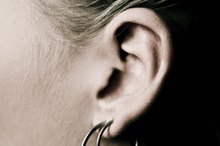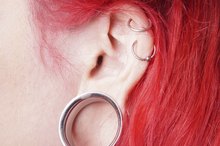Home Remedies for Cauliflower Ear
An auricular hematoma, more commonly known as cauliflower ear, occurs when the cartilage of the outer ear is damaged. Boxers and wrestlers are at particular risk for this injury, but any blow to the ear can result in damage and lead to cauliflower ear 1. The name comes from the swollen, blistered appearance of the ear, much like the surface of a cauliflower. If you suffer an ear injury, first aid can help reduce the likelihood of developing cauliflower ear, but home remedies cannot cure cauliflower ear. You will need to see a doctor for treatment.
If you are experiencing serious medical symptoms, seek emergency treatment immediately.
The Injury
Cauliflower ear occurs when the cartilage of the ear separates from the tissue beneath. While a blow to the ear can damage the cartilage, often the injury occurs over time, due to friction that pulls at the cartilage, lifting it off the tissue surface. An example of this kind of friction would be the friction wrestlers endure in head locks, or when their head is pressed against the mat. Over time the cartilage loses its blood supply from the supporting tissue and dies, crinkling up and taking on a cauliflower appearance. By this time, only medical treatment or even surgery can restore the ear's appearance.
- Cauliflower ear occurs when the cartilage of the ear separates from the tissue beneath.
- While a blow to the ear can damage the cartilage, often the injury occurs over time, due to friction that pulls at the cartilage, lifting it off the tissue surface.
Treatment
How to Treat an infected ear piercing
Learn More
When you experience an injury to your ear's cartilage you'll notice blood and fluid connecting just under the skin's surface, causing the ear to be swollen and tender. Your doctor will treat this by using a syringe to draw out this excess blood and fluid, allowing the cartilage and tissue to adhere together again. Sometimes the doctor will make a small slit with a scalpel to allow more fluid to drain. Do not attempt these treatments at home. Doing so could lead to infection and scarring. After the fluid drains a tight bandage helps encourage the cartilage and tissue to adhere once more.
- When you experience an injury to your ear's cartilage you'll notice blood and fluid connecting just under the skin's surface, causing the ear to be swollen and tender.
- Your doctor will treat this by using a syringe to draw out this excess blood and fluid, allowing the cartilage and tissue to adhere together again.
Prevention
Wearing protective head gear whenever you wrestle, box or perform martial arts is the best way to prevent cauliflower ear. You should wear this head gear even when you're practicing, advises Dr. Douglas Wyland, a South Carolina orthopedic surgeon and former wrestler who suffers from cauliflower ear himself, the result of failing to wear headgear during wrestling practice when he was younger. Repeated minor injuries and pressure experienced during practice can lead to cauliflower ear.
First Aid
Health Risks Associated With Cartilage Ear Piercings
Learn More
If you experience an ear injury and your ear begins to swell, see your doctor. Draining the ear is the only effective treatment to prevent cauliflower ear. You can take acetaminophen for the pain, but avoid aspirin, as this can cause you to bleed more freely and increase the swelling. You may need to take antibiotics and may not be able to practice your sport for 7 to 10 days while your ear heals.
- If you experience an ear injury and your ear begins to swell, see your doctor.
Related Articles
References
- Cauliflower, raw. FoodData Central. U.S. Department of Agriculture. Published April 1, 2019.
- Slavin JL. Carbohydrates, dietary fiber, and resistant starch in white vegetables: Links to health outcomes. Advances in Nutrition. 2013;4(3):351S-5S. doi:10.3945/an.112.003491
- Moores CJ, Fenech M, O’Callaghan NJ. Telomere dynamics: The influence of folate and DNA methylation. Ann NY Acad Sci. 2011;1229:76-88. doi:10.1111/j.1749-6632.2011.06101.x
- Dahl WJ, Stewart ML. Position of the Academy of Nutrition and Dietetics: Health implications of dietary fiber. J Acad Nutr Diet. 2015;115(11):1861-70. doi:10.1016/j.jand.2015.09.003
- Pollock RL. The effect of green leafy and cruciferous vegetable intake on the incidence of cardiovascular disease: A meta-analysis. JRSM Cardiovasc Dis. 2016;5. doi:10.1177/2048004016661435
- Ahmed FA, Ali RF. Bioactive compounds and antioxidant activity of fresh and processed white cauliflower. BioMed Research International. 2013. doi:10.1155/2013/367819
- National Cancer Institute. Cruciferous vegetables and cancer prevention. Updated June 7, 2012.
- Scott O, Galicia-Connolly E, Adams D, Surette S, Vohra S, Yager JY. The safety of cruciferous plants in humans: A systematic review. J Biomed Biotechnol. 2012;2012:503241. doi:10.1155/2012/503241
- American Academy of Allergy Asthma and Immunology. Oral allergy syndrome (OAS) or pollen fruit syndrome (PFS).
- Bajaj JK, Salwan P, Salwan S. Various possible toxicants involved in thyroid dysfunction: A review. J Clin Diagn Res. 2016;10(1):FE01-3. doi:10.7860/JCDR/2016/15195.7092
- Cauliflower, pickled. FoodData Central. U.S. Department of Agriculture. Published April 1, 2020.
- Rice, white, cooked. FoodData Central. U.S. Department of Agriculture. Published April 1, 2019.
- Rice, brown, cooked. FoodData Central. U.S. Department of Agriculture. Published April 1, 2019.
- Riced cauliflower. FoodData Central. U.S. Department of Agriculture. Published April 1, 2019.
Writer Bio
Cynthia Myers is the author of numerous novels and her nonfiction work has appeared in publications ranging from "Historic Traveler" to "Texas Highways" to "Medical Practice Management." She has a degree in economics from Sam Houston State University.








